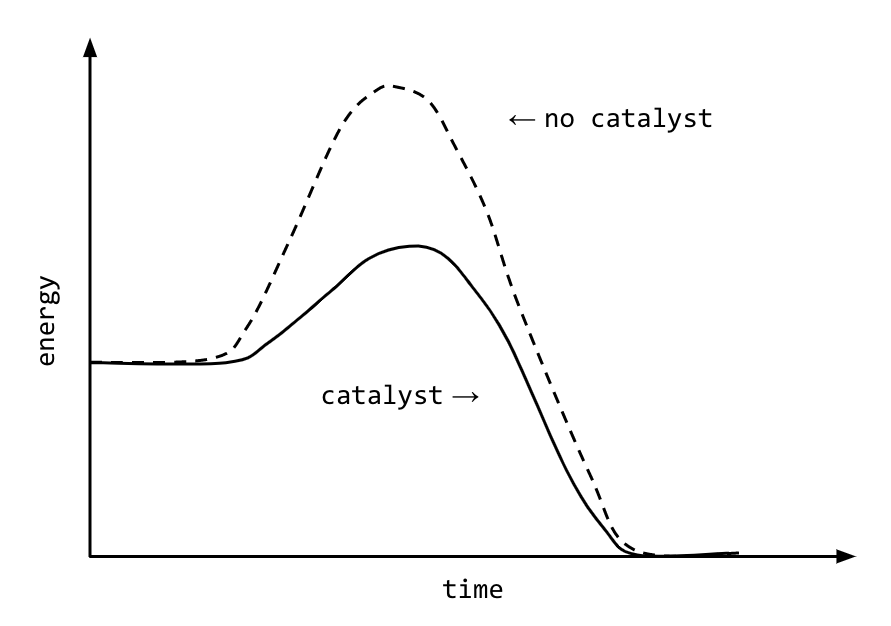In chemistry, activation energy is the energy that must be provided to result in a chemical reaction. The more energy is needed, the harder it is to start the chemical reaction. In work and life as well, we sometimes need to get over the initial hump of getting started.
For instance, it can be hard to get out of bed, or to start studying for an exam—but once you get started, you find it quite easy to keep going with a task. The activation energy metaphor can be helpful to understand why the most challenging part is often to get started. How much energy do you need? Which specific catalysts would be helpful?
“You may not feel outstandingly robust, but if you are an average-sized adult you will contain within your modest frame no less than 7 x 1018 joules of potential energy—enough to explode with the force of thirty very large hydrogen bombs, assuming you knew how to liberate it and really wished to make a point.” — Bill Bryson, A Short History of Nearly Everything.
Minimum amount of energy
Oftentime, we make the process of starting much harder than it should be. We add unnecessary steps that add friction and make us less likely to get started. For instance, we sign up to a gym that is too far away from where we live; instead of striving for simple repetitions, we give ourselves overly ambitious goals; and we don’t align our habits with our goals.
The very first way to apply the activation energy principle is to simply lower the amount of energy we need to perform an action. How can we make it simpler? Look at your tools and processes in order to remove any unnecessary steps. Ask yourself and others whether there is an easier way to get something done.
One of the easier hacks to lower the minimum amount of energy needed to start a task is to make sure you have enough energy in the first place. And the most effective way to have enough energy in the first place is to feel well rested. Getting a good night of sleep can make it much easier to start working on a project or to build a new habit.
Beyond decluttering the process and being well rested, another approach is to break down the task into smaller chunks that require less activation energy. Instead of one big goal, try to focus on more achievable milestones. You will often find yourself motivated enough to keep going once you have managed to get started. For instance, instead of aiming for a full chapter, aim for one page. Instead of aiming for a full hour of creative writing, aim for five minutes.
But lowering the minimum amount of energy you need to get started is not the only way to apply the activation energy principle. You can also use catalysts to facilitate the metaphorical chemical reaction you are aiming for.
Identifying your catalysts
Catalysis is the process of speeding up a chemical reaction by lowering the required threshold of activation energy. A catalyst basically makes it easier for a reaction to happen. When you need to start working on a project or to motivate yourself for a task, it can be helpful to add a personal catalyst.
- Energetic linking. Try to link the task you are trying to perform or the habit you are trying to create with an existing activity which requires very low levels of activation energy. For example, if you are trying to take vitamin supplements or to stretch once a day, do it while your coffee is brewing. If the goal is to do spaced repetition, do it while you’re on the bus on your way to work. To listen to a podcast everyday, play an episode while you shower in the morning. These catalysts will lower the amount of energy you need to build these habits.
- Energizing environment. The field of environmental psychology explores the interplay between people and their surroundings. Your environment can act as a catalyst to make it easier to achieve your goals. If you are trying to study, go to the library for a quiet environment, surrounded by people focused on getting ready for their exams. If you are struggling to run everyday, put your running shoes right next to the door so you can’t miss them when you leave the house. Create catalysts in your environment to prime yourself to act.
- Energy incentives. Sometimes, a little incentive can become a catalyst that means you don’t need as much energy to get something done. Not completing the task feels like more work than completing it. An accountability partner is a great way to create an incentive: would you rather complete the task you promised you’d tackle, or spend more energy explaining to your accountability partner why you did not do it? This kind of arrangement works especially well in creative fields where both accountability partners have similar goals.
By linking habits together, designing the right environment, and creating incentives, you can create catalysts to considerably lower the amount of activation energy necessary to get started. And once you got started, it’s much easier to get going. That’s the paradoxical power of inertia, another concept from chemistry: unless an outside force acts on it, a body at rest will remain at rest and a body in motion tends to stay in motion. Use the right amount of energy to get started, then it will be much easier to stay in motion!

